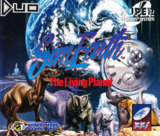Will Wright's first attempt at an evolution simulator
The major task in SimEarth is to manage a planet. You do so in two main ways, one is though the four control panels, and the other is through the Placer tool.
The four control panels are the Geographic, the Atmospheric, the Biological, and the Civilization panels. Using these panels enables the player to make sweeping changes to the way the planet operates. For example, one may use the Geographic panel to slow the rate of continental drift or the frequency of meteor strikes, the Atmospheric panel to set the level of cloud cover and rainfall, the Biological to fiddle with the rate of lifeform reproduction and mutations, and the Civilization panel to control what sources of fuel any intelligent lifeforms may use. Those are only a few examples, each panel allows for many other methods of customization.
The Placer tool allows the player to place different terraforming machines and lifeforms on the planet's surface. It also gives the ability to cause meteor and ice meteor strikes as well as placing Monoliths to force evolution.
Each method of management costs energy to undertake, and the level of energy the player has is decided by what difficulty level they are playing on. The energy itself also recharges on its own throughout the course of the game.
SimEarth has a "Random Planet" mode, a Scenario mode, and a weird "Daisyworld" mode. In the Random Planet mode, the player starts at the violent birth of a new planet and must cultivate plant and animal life, with the eventual goal of providing optimal conditions for an intelligent form of animal life to evolve and advance to the point where it can leave and colonize space. This is the most varied and interesting mode because just about anything can happen, from dead iceball worlds to desert planets where reptiles rule, and even water worlds with intelligent fish that build cities. Earth-like planets can also be created if so desired. The game doesn't end until 10 billion years after it begins, when the planet's star becomes a red giant and engulfs the world.
In the scenario mode, the player is given a specific goal to complete in order to win, usually within a specified time frame. Scenarios include Cambrian Earth, Modern Earth, Terraform Mars, and Terraform Venus to name a few. Some of the missions are very difficult to complete, but still a lot of fun.
The final Daisyworld mode is an illustration of the Gaia Hypothesis that states that plant and animal life regulate the temperature of a planet. This is the least interesting mode because the only existing lifeforms are multicolored daisies.
SimEarth is a very fun software toy that allows many different possibilities for planet types and animal life. Often the most interesting thing to do is to have a lush, perfect planet, and then suddenly boil the oceans away or turn the Sun off to see what can survive in the forbidding new world. It is doubly fun when there are intelligent species around that try to cling to whatever kind of survival they can.
I recommend the game to anyone that liked the Terraforming part of Spore or to anyone interested in Earth Science as a whole. It is a very interesting game.

